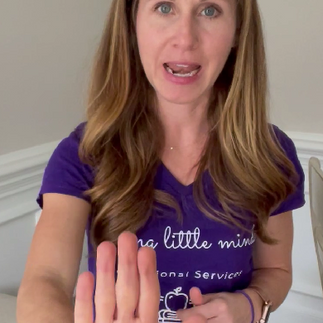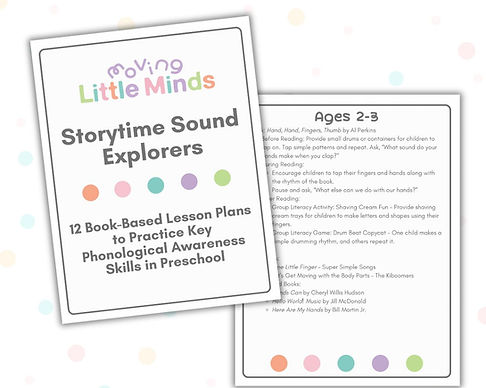The ABCs of Early Education: Why Teaching Letter Sounds is a MUST for Preschoolers!
- Melissa McCall
- May 22, 2023
- 6 min read
Updated: Jun 5, 2025
Letter Sounds are a Critical Early Literacy Skill

Letter sounds. They are quite possibly the single most important academic skill that children must learn to be well-prepared to read. Letter sounds are the backbone of phonics instruction…children can begin to decode words and understand how written language works with a strong letter sound foundation. This knowledge is critical for reading comprehension, and it lays the foundation for success in all aspects of education. The science of reading has proven that children must make connections between speech (understanding speech sounds) and vision (recognizing letters and letter patterns by sight) in order to learn to read. As teachers and parents of preschool children, we can incorporate simple yet intentional activities into our children’s lives that build this foundation, giving our children a clear path to success when learning to read and decode.
What Kindergarten Teachers Are Saying!
In 2022, I presented a survey to North Carolina teachers about kindergarten readiness. Approximately 40 teachers answered from around the state. When kindergarten teachers were asked, “What’s the single most important skill you would hope parents and preschool teachers would focus on?” the top requested skill was letter sound knowledge. The survey also reported on kindergarten readiness in literacy. When I asked if the students in

their classroom that attended preschool were prepared in literacy for kindergarten, teachers replied that 25% of those students that DID attend kindergarten were not well-prepared in literacy. As parents and teachers of preschool children, we want to give our children the path of least resistance in school. There is nothing more heartbreaking than seeing a child struggle to read. I have been there, both personally with my own child, and professionally as a kindergarten teacher. I have learned so much more over the years about the research behind learning to read. It is my mission to share this knowledge so that parents and teachers of young children do not have to face this obstacle with their children and students.
WHY are Children Lacking These Skills?

We know that learning letter sounds is important. But, HOW exactly can we best teach letter sounds to young children? Why are many children that attend preschool still lacking basic foundational skills? I do not doubt that the majority of preschool teachers understand the importance of teaching letter sounds to their students. I have been into numerous classrooms in the area, and preschool teachers ARE teaching letter names and sounds. However, often times teachers are unaware of best practices and research behind the ways in which children acquire letter sound knowledge. The NAEYC states in their latest book, Literacy Learning for Infants, Toddlers, and Preschoolers, that, “Among early childhood educators there is a misconception that children should not be taught letters out of context...However, research suggests that stand-alone lessons and sounds are actually more effective, (Wright et al., 2022).

Simply put…Explicit instruction matters! We must dedicate short periods of time to TEACHING young children skills that support early literacy development and growth. Should we sit and drill our children for twenty minutes on the carpet? Absolutely not! Should we work on teaching letter names and sounds through explicit instruction that incorporates movement and purposeful play? YES! So, let’s dive in to HOW we can best teach letter sounds to our children!
HOW to Best Teach Letter Sounds to Our Children.

1. Teach letters in cycles. Introducing a letter per week is not effective for our children! Instead, exposing children to each letter name and sound in the alphabet multiple times throughout the year gives preschool children an opportunity to gain adequate exposure and mastery of basic letter sounds. While research shows that that children acquire letter names and sounds in a variety of orders, children typically learn these skills first:
o Letters in names.
o Letters at the beginning of the alphabet
o Letters that have names that include their matching sounds at the beginning or end. For example, the letter Bb has the /b/ sound at the beginning of the letter name. The letter Ss has the /s/ sound at the end of the letter name.
If you are interested in learning more about my recommended letter cycles, reach out!
2. Use movement. A study with approximately 150 children ages 5-6 found that, “...Children who used their whole body to shape the sounds of letters became twice as proficient at letter sounds that are more difficult to learn compared to those who received traditional instruction (University of Copenhagen, 2022). Check out THESE letter sound/motion cards, which are a FAN favorite among teachers and parents!
3. Reference mouth formations for difficult sounds. Learning sounds can be HARD! Model how to form the sound, point to your mouth, and practice! If this is a particular issue for your child, HERE is a great resource to help you! (Amazon Associate Link).
4. Dedicate time to explicitly teaching letter sounds. Set aside 5-10 minutes per day to teaching letter sounds. Children must be TAUGHT, then engage in purposeful play around the skills we are teaching them.
5. Continually review previous learned sounds in fun, engaging ways. Practice really does make perfect, and learning letter sounds can be a challenge for some children. I love to make reviewing the sounds FUN, by incorporating the letter sound body motions while we sing, "Who let the Aa out…aaaaaa!" There have been reports of children singing this song in the shower!
6. Clip the sounds. This is a tricky one! Often times, children are taught to pronounce the sounds improperly. For example, some children say "buhhhh" instead of a short, quick, "b". This can be problematic when children begin to decode and write. I recommend that you correct this problem as soon as possible, before bad habits form! Other letters that often have this problem include: c, d, f, k, l, m, n, p, r, t
7. Incorporate a key word and picture for children to reference when learning the sounds. Example: Aa = apple. It is so important for children to have a visual reminder of the sound when they are beginning to learn the alphabet. When choosing alphabet charts, be sure to look for pictures that feature proper sounds and no beginning blends. Here is an example!
8. Dedicate time to building phonological and phonemic awareness skills along side of phonics instruction. Research has proven that Phonics + Phonemic Awareness is the KEY to success! When children are able to auditorily recognize sounds, they begin to understand how sounds work within print, which aids in reading abilities. Read more about the importance of phonological awareness HERE.
9. Make it FUN and ENGAGING!
Make Learning Letter Sounds FUN and ENGAGING!

Multi-Sensory Learning: Use multisensory tools to practice writing letter sounds (sand trays, gel bags, sandpaper letters, paintbrushes and water, Magna doodles, whiteboards).
Play “ I Spy”: Say, “I spy with my little eye, an object that begins with the ____ sound.” Hunt for the objects! Switch roles!
Nature Hunt: Grab a clipboard and head out on a letter hunt around the house or neighborhood. Here is a FREE worksheet to use on your hunt.
ABC Books: Choose alphabet books with clear, simple illustrations and make letter/sound and object connections while reading.
Letter Brainstorm: Choose a letter of the day. Brainstorm 5 words that begin with that letter sound. Hunt for the letter around the house and in your favorite ABC books.
Mystery Bag: Make a mystery bag full of objects of the same sound – Can you guess the letter of the day?
Grab Some of My Favorite ABC Products (Amazon Associate Links):
Don't miss an update from Moving Little Minds! SUBSCRIBE HERE!

We believe that every child deserves a bright future, and this begins with a strong foundation in early literacy skills. At Moving Little Minds, we are dedicated to providing research-based literacy activities in fun and engaging ways! By merging instruction with play, we ensure that children are reaching their full potential and embark on their educational journey well-prepared for the future! Let's build those KEY emergent literacy skills together.
References:
Castiglioni-Spalten, M. L., & Ehri, L. C. (2003). Phonemic awareness instruction: Contribution of articulatory segmentation to novice beginners’ reading and spelling. Scientific Studies of Reading, 7(1), 25–52. https://doi.org/10.1207/s1532799xssr0701_03
Clayton, F. J., West, G., Sears, C., Hulme, C., & Lervåg, A. (2019). A longitudinal study of early reading development: Letter-sound knowledge, phoneme awareness and ran, but not letter-sound integration, predict variations in reading development. Scientific Studies of Reading, 24(2), 91–107. https://doi.org/10.1080/10888438.2019.1622546
Drouin, M., Horner, S. L., & Sondergeld, T. A. (2012). Alphabet knowledge in preschool: A Rasch model analysis. Early Childhood Research Quarterly, 27(3), 543–554. https://doi.org/10.1016/j.ecresq.2011.12.008
Piasta, S. B., & Wagner, R. K. (2010). Learning letter names and sounds: Effects of instruction, letter type, and Phonological Processing Skill. Journal of Experimental Child Psychology, 105(4), 324–344. https://doi.org/10.1016/j.jecp.2009.12.008
Schuele, C. M., & Boudreau, D. (2008). Phonological awareness intervention: Beyond the basics. Language, Speech, and Hearing Services in Schools, 39(1), 3–20. https://doi.org/10.1044/0161-1461(2008/002)
University of Copenhagen - Faculty of Science. (2022, June 8). Whole-body learning can boost children's letter sound recognition -- the first step toward reading: Children who move while learning sounds of letters significantly improve their ability to recognize individual letter sounds. ScienceDaily. Retrieved August 9, 2022 from www.sciencedaily.com/releases/2022/06/220608091403.htm
Wright, T. S., Cabell, S. Q., Duke, N. K., & Souto-Manning, M. (2022). Literacy learning for infants, toddlers, and preschoolers: Key practices for educators. National Association for the Education of Young Children.




































%20(52).jpg)

Comments